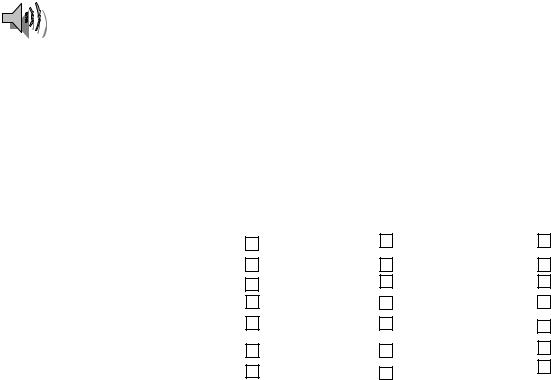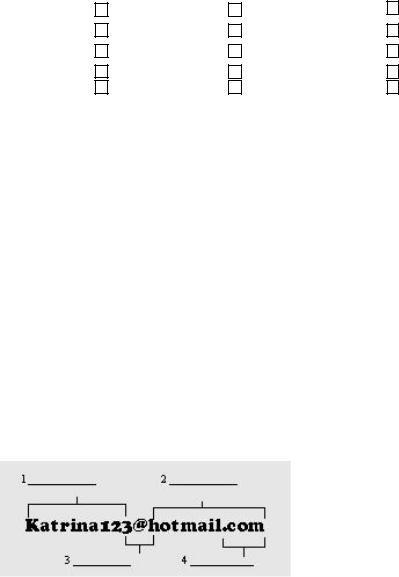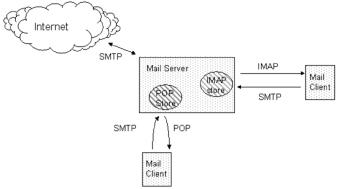
IT_book
.pdf
3.Which protocol doesn’t filter down the messages to the user’s boxes?
A)SMTP.
B)POP.
C)IMAP.
D)none of the above.
4.IMAP has …
A)less options than POP.
B)more options than POP.
C)another name – POP2.
D)another name – POP3.
VOCABULARY AND GRAMMAR
4.Use the words on the right to form one word that fits in the same space in the text.
Spam |
|
There is no doubt that one of the |
BIG |
1) ____________ black clouds hanging over e- |
|
mail is spam. Spam can be 2) _________ any |
CONSIDER |
electronic junk mail (generally e-mail adverti- |
|
sing for some product) that is sent out to thou- |
|
sands, if not millions, of people with an e-mail |
WASTE |
address. In addition to 3) ___________people's time with |
|
4) _________ e-mail, spam also eats up a lot of network band- |
WANT |
width. |
|
Many individuals are able to use spam filters in their e-mail cli- |
ANNOY |
ents to help filter some of the 5) ____________ out of their in- |
|
box, but for some corporations more strict 6) __________ |
SPAM |
measures are needed because of the sheer volumes of junk mail. |
|
Microsoft, for example, receives about 10 million e-mails per |
FILTER |
day via the Internet. Of those 85 to 90 percent is 7) ________ |
|
out as spam. Having an e-mail client download this huge num- |
|
ber of spam mail would simply take too long. For this reason |
|
many corporations and companies will use spam filters at the |
|
server level (instead of the client) to help keep the spam e-mails |
REACH |
from ever 8) ____________an employee's computer. |
71
5. What do these abbreviations mean? Look up the ones you don’t know in a dictionary.
ASP, IMAP, CGI, PHP, ATM, XUL, WebDAV, XSS, WAP, API, AVI, Bps, ISDN, LAN, MIME, NAP, PDF, PING, PPP, SAN, SLIP, TCP.
EXPLANATIONS AND DEFINITIONS
Texts containing technical terminology frequently contain definitions and explanations. This is particularly the case if the text is aimed at non-experts or students of technical subjects, or if the purpose of the text is to inform specialists about new developments.
1.Common words and expressions used in definitions or explanations are listed below.
is / are |
by … we mean |
means |
by … is meant |
is taken to be |
in other words |
denotes |
that is (to say) |
is / can be defined as |
|
Examples:
Netiquette is a form of online etiquette.
E-mail (electronic mail) can be defined as a system for sending and receiving messages on a single computer system or on an interconnection of computer systems, such as the Internet.
Virtual reality refers to computer simulations of real-world "environments" that use 3D graphics and external devices like a data glove or helmet to allow users to interact with the simulation.
2.Some definitions and explanations give further distinguishing characteristics by means of a defining clause.
Examples:
An avatar is an icon in chats and games which represents a participant.
AVI is a Microsoft video format where audio and video coding appears in alternate segments.
72

3.Another way of defining or explaining is to use a noun, a noun phrase, or a clause separated from the rest of the sentence by commas or dashes.
Examples:
Computers – electronic devices for processing information – are now used in practically every aspect of life. (noun phrase)
Blogs, chronological records of thoughts, links, events, or actions which are posted on the web, are very popular nowadays. (clause)
6.Study the following definitions. A definition usually includes three parts: the term to be defined, the group it belongs to, and the characteristics which distinguish it from other members of the group.
Term |
Group |
Characteristics |
A browser |
is a software |
that loads and displays a |
|
|
web page. |
Now analyse the following definitions and identify the different parts.
1.A chain letter is a form of spam which asks you to distribute the letter to many other people.
2.By chat we mean a form of real-time electronic communications where participants type what they want to say, and it is repeated on the screens of all other participants in the same chat.
3.Spim can be defined as spam sent by instant messaging.
4.A virus refers to a destructive program that has the ability to reproduce itself and infect other programs or disks.
7. Give your own definitions to the following terms.
Wi-Fi, cyberspace, a cookie, Java, a password, a plug-in, a directory.
 SPEAKING
SPEAKING
8.Work in pairs. How do you feel about getting these unwelcome messages? Why? Add other types of unwanted communication to the list.
Wrong number phone calls ● spam ● viruses ● junk mail ● joke calls ● bills ● calls from telephone salespeople
9. Role play the following situation in pairs:
Spammer Sally: You are an e-mailaholic. If you had a choice, e-mail would be the only form of communication. You love sending and receiving e-mails, no matter who they are from.
73

Garry: You are Sally’s best friend. You are worried about Sally’s behaviour. Explain him about Internet addiction and why spam is such a problem.
10. Study a real situation happened to one company. Give your opinion on this problem. Then answer the questions below.
An information security manager routinely monitored the contents of electronic correspondence among employees. She discovered that many employees were using the system for personal purposes. Some messages were love letters, and others related to football betting pool. The security manager prepared a list of the employees, with samples of their messages, and gave them to the management. Some managers punished their employees for having used the corporate e-mail for personal purposes. Some employees, in turn, objected to the monitoring, claiming that they should have the same right to privacy as they have using the company’s interoffice mail system.
a)Is monitoring of e-mail by mangers ethical? (It is legal.) Why do you feel so?
b)Is the use of e-mail by employees for personal communication ethical? Why or why not?
c)Is the security manager’s submission to management of a list of abusers ethical? Why or why not?
d)What should the company do in order to rectify the situation?
LISTENING
11.Compare how many e-mails, phone calls and letters you make/send and receive each week.
12.Here are three typical responses on the question “Which do you like using most: e-mail, telephones or the post?” Listen to the different opinions on this question. Which one do you most agree with?
Tick the features of each type of communication. |
|
|
Telephone |
Post |
|
cheap |
|
|
send pictures/images |
|
|
instant delivery |
|
|
instant reply |
|
|
interactive |
|
|
modern |
|
|
private |
|
|
74

secure slow
send sound
unwanted communication usually formal
13.Listen to the text about e-mail addresses and servers, and answer the questions.
What do the two types of mail server do?
What are the parts of an e-mail address?
How many types of e-mail client are there?
What happens when you send an e-mail?
14.Decide if the sentences are True or False.
1. |
You cannot choose your own user name. |
T / F |
2. |
The domain name shows the network. |
T / F |
3. |
.edu and .com are TLDs. |
T / F |
4. |
A DNS sends an e-mail to a POP3 server. |
T / F |
15. Label the parts of the e-mail address.
 WRITING
WRITING
16. You are going to design an e-mail policy for your University.
Write a letter to your University authorities with your ideas. The letter should be of between 120–180 words in an appropriate style.
75

SECTION 2
 READING
READING
1. Read the text and translate it.
E-MAIL PROTOCOLS
Basically, a protocol is about a standard method used at each end of a communication channel, in order to properly transmit information. In order to deal with your e-mail you must use a mail client to access a mail server. The mail client and mail server can exchange information with each other using a variety of protocols.
Simple Mail Transfer Protocol (SMTP) is the de facto standard for e-mail transmissions across the Internet. SMTP is a relatively simple, text-based protocol, where one or more recipients of a message are specified (and in most cases verified to exist) and then the message text is transferred. It is quite easy to test an SMTP server using the telnet program. SMTP uses TCP port 25. To determine the SMTP server for a given domain name, the MX (Mail eXchange) DNS record is typically used, falling back to a simple A (address) record in the case of no MX. SMTP is a "push" protocol that does not allow one to "pull" messages from a remote server on demand. To do this a mail client must use POP3 or IMAP.
SMTP developed out of Mail Box Protocol (1971), FTP Mail (1973), and Mail Protocol. The work continued throughout the 1970s, until the ARPANET converted into the modern Internet around 1980. Jon Postel then proposed a Mail Transfer Protocol in 1980 that began to remove the mail's reliance on FTP. SMTP was published as RFC 821 in 1982, also by Jonathan Postel.
After establishing a connection between the sender (the client) and the receiver (the server), the following is a legal SMTP session. In the following con-
76
versation, everything sent by the client is prefaced with C: and everything sent by the server is prefaced with S:. On most computer systems, a connection can be established using the telnet command on the client machine, for example.
telnet www.example.com 25
which opens a TCP connection from the sending machine to the MTA listening on port 25 on host www.example.com.
S: 220 www.example.com ESMTP Postfix C: HELO mydomain.com
S: 250 Hello mydomain.com
C: MAIL FROM:<sender@mydomain.com> S: 250 Ok
C: RCPT TO:<friend@example.com> S: 250 Ok
C: DATA
S: 354 End data with <CR><LF>.<CR><LF> C: Subject: test message
C: From: sender@mydomain.com C: To: friend@example.com C:
C: Hello,
C: This is a test. C: Goodbye.
C: .
S: 250 Ok: queued as 12345 C: QUIT
S: 221 Bye
One of the limitations of the original SMTP is that it has no facility for authentication of senders. Therefore the SMTP-AUTH extension was defined. However, the impracticalities of widespread SMTP-AUTH implementation and management means that e-mail spamming is not and cannot be addressed by it.
Modifying SMTP extensively, or replacing it completely, is not believed to be practical, due to the network effects of the huge installed base of SMTP. Internet Mail 2000 is one such proposal for replacement.
2.For questions 1–5, choose the correct answer (A, B, C or D).
1)A protocol is a
A) record of sequential data.
77
B)set of rules for use in various circumstances.
C)program used for connecting to a server.
D)description of a server operating system.
2)Protocol SMTP is used for
A)transferring e-mail messages between servers.
B)delivery e-mails from a mail-server to a client machine.
C)sending e-mail messages over FTP protocol.
D)for reading e-mail messages.
3)Protocol SMTP is the de facto standard for e-mail transmissions because
A)it is the perfect protocol for e-mail transmissions.
B)there is no alternative to it.
C)it includes authentication tools.
D)it is widely used.
4)When SMTP server for a given domain name is determined by address DNS record?
A)Always.
B)If there are several MX DNS records for this domain name.
C)If there is no MX DNS record for this domain name.
D)If DNS server is not accessible.
5)What is the meaning of the following sentence from the text: “The impracticalities of widespread SMTP-AUTH implementation means that e-mail spamming is not and cannot be addressed by it”?
A)It is impossible to define e-mail addresses of spammers.
B)SMTP-AUTH extension cannot solve the problem with spamming.
C)Using SMTP-AUTH results in increasing the number of spam e-mails.
D)SMTP-AUTH extension is not used on each mail server so it doesn’t help to solve the problem with spamming.
3. Read the text and translate it.
POP3 AND IMAP
Local e-mail clients use the Post Office Protocol version 3 (POP3), an ap- plication-layer Internet standard protocol, to retrieve e-mail from a remote server over a TCP/IP connection.
The design of POP3 and its procedures support end-users with intermittent connections (such as dial-up connections), allowing these users to retrieve e-mail when connected and then to view and manipulate the retrieved messages
78
without needing to stay connected. Although most clients have an option to leave mail on server, e-mail clients using POP3 generally connect, retrieve all messages, store them on the user's PC as new messages, delete them from the server, and then disconnect. In contrast, the newer, more capable Internet Message Access Protocol (IMAP) supports both connected and disconnected modes of operation. E-mail clients using IMAP generally leave messages on the server until the user explicitly deletes them. This and other facets of IMAP operation allow multiple clients to access the same mailbox. Most e-mail clients support either POP3 or IMAP to retrieve messages; however, fewer Internet Service Providers (ISPs) support IMAP.
Like many other older Internet protocols, POP3 originally supported only an unencrypted login mechanism. Although plain text transmission of passwords in POP3 still commonly occurs, POP3 currently supports several authentication methods to provide varying levels of protection against illegitimate access to a user's e-mail. One such method, APOP, uses the MD5 hash function in an attempt to avoid replay attacks and disclosure of a shared secret.
POP3 works over a TCP/IP connection using TCP on network port 110. E-mail clients can encrypt POP3 traffic using TLS or SSL. A TLS or SSL connection is negotiated using the STLS command.
Dialog example:
S: <wait for connection on TCP port 110> C: <open connection>
S: +OK POP3 server ready <1896.697170952@dbc.mtview.ca.us>
C:APOP mrose c4c9334bac560ecc979e58001b3e22fb
S: +OK mrose's maildrop has 2 messages (320 octets)
C:STAT
S:+OK 2 320
C:LIST
S:+OK 2 messages (320 octets)
S:1 120
S:2 200
S:.
C:RETR 1
S:+OK 120 octets
S:<the POP3 server sends message 1>
S:.
79
C:DELE 1
S:+OK message 1 deleted
C:RETR 2
S:+OK 200 octets
S:<the POP3 server sends message 2>
S:.
C:DELE 2
S:+OK message 2 deleted
C:QUIT
S: +OK dewey POP3 server signing off (maildrop empty)
C:<close connection>
S:<wait for next connection>
POP3 servers without the optional APOP command expect you to log in with the USER and PASS commands:
C:USER mrose
S:+OK User accepted
C:PASS mrosepass
S: +OK Pass accepted
(from http://everything.explained.at)
4.Answer the following questions.
1)What should be done in order to hide a password from the eavesdroppers while receiving e-mails?
2)What is the main advantage of IMAP protocol in comparison with POP3 protocol?
3)What port does POP3 run on?
4)How POP3 traffic can be encrypted?
5)Does POP3 protocol allow a client to leave the e-mail messages on the server after receiving them?
5.Complete the following sentences with the most suitable word.
1)The POP3 protocol ______ users to retrieve e-mail messages.
2)The command ______ is used for sending encrypted password.
3)In many old Internet protocols passwords are not ______.
4)When e-mail messages are retrieved to a client machine using POP3 protocol, they are usually ______ from the server.
80
